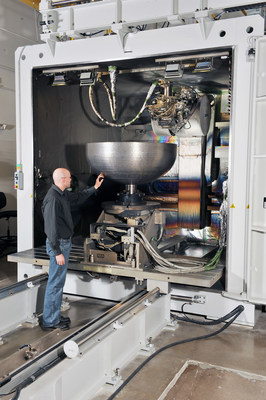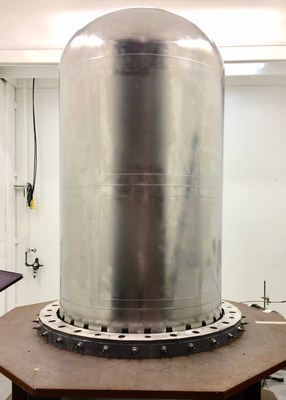Tank delivery time slashed from two years to three months, continues Lockheed Martin sprint to cut satellite cost and schedule by 50 percent
DENVER, July 11, 2018 — (PRNewswire) — Lockheed Martin (NYSE: LMT) has embraced a 3-D printed titanium dome for satellite fuel tanks so big you can't even put your arms around it. The 46-inch- (1.16-meter-) diameter vessel completed final rounds of quality testing this month, ending a multi-year development program to create giant, high-pressure tanks that carry fuel on board satellites.
The titanium tank consists of three parts welded together: two 3-D printed domes that serve as caps, plus a variable-length, traditionally-manufactured titanium cylinder that forms the body.
"Our largest 3-D printed parts to date show we're committed to a future where we produce satellites twice as fast and at half the cost," said Rick Ambrose, Lockheed Martin Space executive vice president. "And we're pushing forward for even better results. For example, we shaved off 87 percent of the schedule to build the domes, reducing the total delivery timeline from two years to three months."
Satellite fuel tanks must be both strong and lightweight to withstand the rigors of launch and decade-long missions in the vacuum of space. That makes titanium an ideal material, but procuring 4-foot-diameter, 4-inch-thick titanium forgings can take a year or more, making them the most challenging and expensive parts of the tank. Traditional manufacturing techniques also meant that more than 80 percent of the material went to waste. Now, 3-D printing eliminates all that lost material for the domes, and the titanium used for printing is readily available with no wait time.
"We self-funded this design and qualification effort as an investment in helping our customers move faster and save costs," explained Ambrose. "These tanks are part of a total transformation in the way we design and deliver space technology. We're making great strides in automation, virtual reality design and commonality across our satellite product line. Our customers want greater speed and value without sacrificing capability in orbit, and we're answering the call."
Even the smallest leak or flaw could be catastrophic for a satellite's operations, so Lockheed Martin engineers went to great lengths to ensure the printed tanks meet or exceed the performance and reliability required by NASA. Engineers and technicians rigorously evaluated the structure, conducting a full suite of tests to demonstrate high tolerances and repeatability.
The tank domes are a leap in size for qualified 3-D printed materials. The largest part previously qualified was a toaster-size electronics enclosure for the Advanced Extremely High Frequency satellite program. Lockheed Martin's recent accomplishment continues a path of 3-D printed parts that bloomed in recent years. Since the company launched the first ever printed parts into deep space aboard NASA's Juno spacecraft, it has produced thousands of flight components and even more for tooling and prototyping using a variety of metals and composites.
Technicians used Electron Beam Additive Manufacturing® to produce these domes in the largest 3-D printer at our facility in Denver. Lockheed Martin now offers the tank as a standard product option for LM 2100 satellite buses.
About Lockheed Martin
Headquartered in Bethesda, Maryland, Lockheed Martin is a global security and aerospace company that employs approximately 100,000 people worldwide and is principally engaged in the research, design, development, manufacture, integration and sustainment of advanced technology systems, products and services. This year the company received three Edison Awards for ground-breaking innovations in autonomy, satellite technology and directed energy.


![]() View original content with multimedia:
http://www.prnewswire.com/news-releases/giant-satellite-fuel-tank-sets-new-record-for-3-d-printed-space-parts-300679468.html
View original content with multimedia:
http://www.prnewswire.com/news-releases/giant-satellite-fuel-tank-sets-new-record-for-3-d-printed-space-parts-300679468.html
SOURCE Lockheed Martin
| Contact: |
| Company Name: Lockheed Martin
Mark Lewis Phone: +1 408-203-8093 / Email Contact Web: http://www.lockheedmartin.com Financial data for Lockheed Martin |









